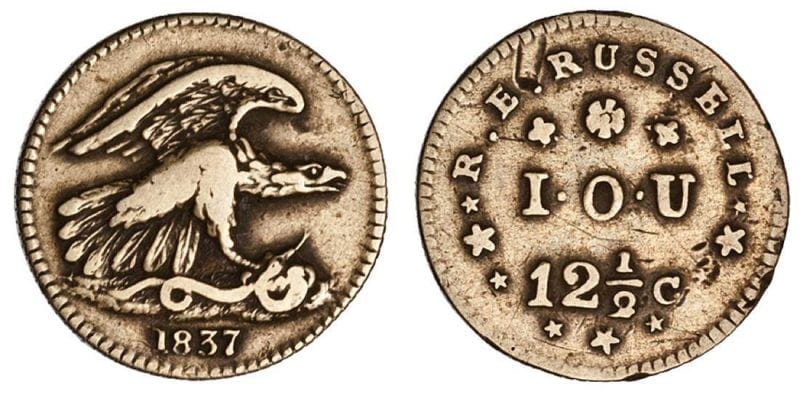DAVIDSON HISTORY
The Mystery of an Eagle and Serpent Coin

150 years ago, E.F.R. published an advertisement in Charlotte’s Western Democrat concerning a token which had recently been used as money in Davidson. His description was as follows:
A Tradesman’s Card, or Token.
A coin, apparently of copper or nickel, about the size of an ordinary Spanish silver twelve and a half cent piece, was passed as money a few days ago at Davidson College.
On the obverse, in the center, are the letters I.O.U., with a star over each; beneath them are the figures 12 ½ c. (I owe you twelve and a half cents). Around the border, above the letters, is the name R.E. Russell, with stars to complete the circle.
On the reverse, in the center, is an Eagle with wings outspread, trampling upon a serpent writhing in its talons, and underneath the date 1837.
Query. With regard to the eagle and serpent, whether they refer to Gen. Jackson’s war upon the old United States Bank, just before? Who can tell where it came from?
(Western Democrat, June 9, 1868)
Were this coin to appear today, it would be valuable, as it is extremely rare. It is the product of a rough economic period in the history of the United States. Starting with his re-election in 1832, Andrew Jackson entered into a controversy with the Bank of the United States and attempted to weaken the Second National Bank in Philadelphia. This affected banks across the nation, which stopped issuing coins for payments and exchanging coins for paper currency. As a result, people began hoarding coins, which removed them from circulation and caused a shortage. Private mints then began producing tokens to fill this void. The Panic of 1837, which produced a severe recession lasting until the mid-1840s, ensued. Such coins, privately minted between 1833 and 1844, are known as “hard times tokens.” These tokens, used for cash, often displayed unusual designs taken from contemporary political campaigns and satire, and sometimes included the names of merchants eager to advertise their products and services.
This token was probably struck by Lewis Feuchtwanger, a doctor, pharmacist, and metallurgist in New York City. The motif of the serpent and the eagle also appears on his one-cent coin, minted about the same time. The token is made from German silver, or argenta, an alloy composed of copper, nickel, zinc, tin, and trace metals.
Although many numismatists identified R.E. Russell as a New York merchant, recent research indicates that the R.E. Russell referred to on the token was probably Robert E. Russell, who owned a seed business, boarding house, botanical garden, and public bath in Columbia, South Carolina. Although the U.S. Congress decreed in 1857 that only coinage produced by the U.S. mint would be considered legal currency, hard times tokens continued to circulate until after the Civil War.
Nancy Griffith
Nancy Griffith lived in Davidson from 1979 until 1989. She is the author of numerous books and articles on Arkansas and South Carolina history. She is the author of "Ada Jenkins: The Heart of the Matter," a history of the Ada Jenkins school and center.


